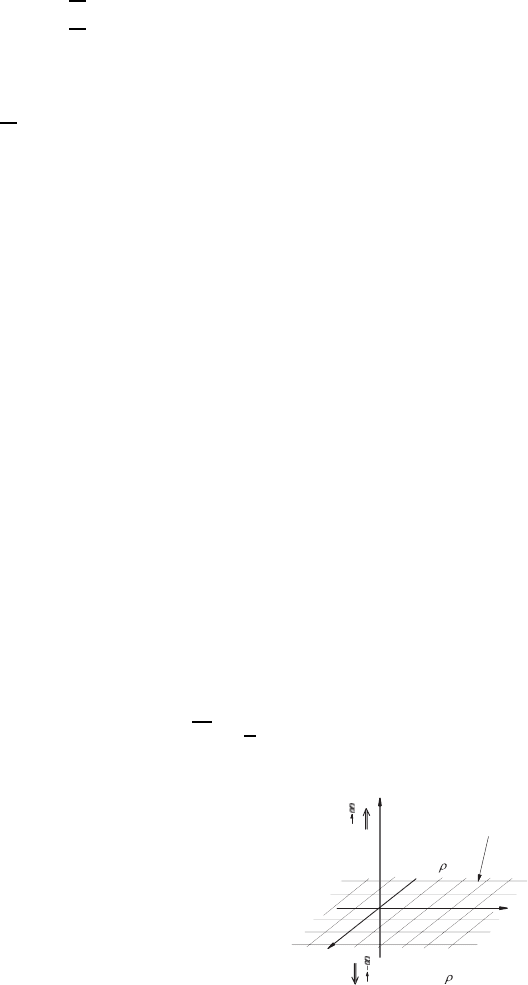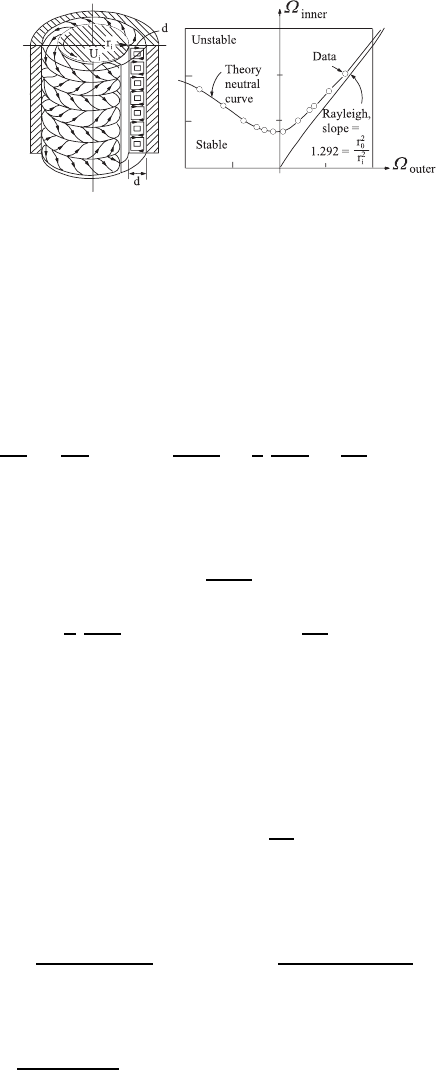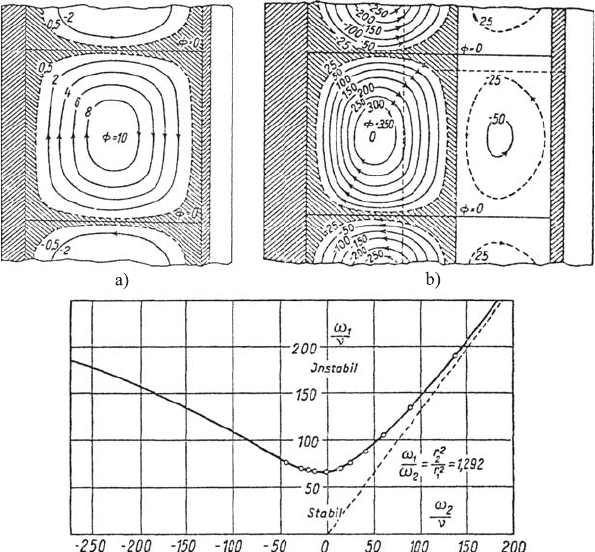Durst F. Fluid Mechanics: An Introduction to the Theory of Fluid Flows
Подождите немного. Документ загружается.


17.2 Causes of Flow Instabilities 503
x
2
T( ) = T -
x
2
x
2
x
2
= z +
z
x
2
= z
T( )
x
2
0
T
0
Temperature
distribution
for
γ γ
a
>
Fig. 17.7 Stability of temperature distribution in the atmosphere
T
(T
)
z
=
P
(P
)
z
κ−1
κ
=
P
P
z
κ−1
κ
, (17.11)
where T
and (T
)
z
are the fluid-element temperature and P
and (P
)
z
represent the corresponding pressures at the considered heights.
From (17.11) one obtains
d(ln T
)=
κ − 1
κ
d(ln P ). (17.12)
From (17.9), it follows that
d(ln P )=−
g
RT
dx
2
(17.13)
so that the following differential equation holds:
d(ln T
)=−
κ − 1
κ
g
RT
dx
2
. (17.14)
From T = T
0
1 −
x
2
c
, it follows that
dT = −
T
0
c
dx
2
= −γ dx
2
. (17.15)
From (17.14) and (17.15), one obtains
dT
T
= −
κ − 1
κ
g
γ
dT
T
. (17.16)
On introducing the adiabatic temperature gradient, common in meteorology:
γ
A
=
κ − 1
κ
g
R
(17.17)

504 17 Unstable Flows
into the above relationship, one can then write
dT
T
=
γ
A
γ
dT
T
(17.18)
or integrated:
T
(T
)
z
=
T
T
z
(γ
A
/γ)
. (17.19)
Due to the deflection of the fluid particle from position z, where it was in
equilibrium with its surroundings, a fluid motion results due to the presence
of the buoyancy force, for which the following equation of motion holds:
ρ
d
2
z
dt
2
=(ρ − ρ
) g (17.20)
or, after further rewriting:
d
2
z
dt
2
= g
T
T
− 1
. (17.21)
Thus, because (T
)
z
= T
z
, (17.21) holds:
d
2
z
dt
2
= g
T
(T
)
z
T
z
T
− 1
(17.22)
and thus one can write for the subsequent considerations
d
2
z
dt
2
= g
⎡
⎣
T (z)
T
z
γ
A
−γ
γ
− 1
⎤
⎦
. (17.23)
For these considerations, it is important to know whether the existing linear
temperature gradient γ = T
0
/c is larger or smaller than the adiabatic temper-
ature gradient of the atmosphere, i.e.
(κ−1)
κ
g
R
≡
g
c
p
>
<
γ decides the stability
of the temperature distribution in the atmosphere.
Hence, the following considerations can be carried out:
• A positive deflection z causes T (z) <T
z
because T = T
0
(1 −z/c), so that
for γ
A
>γit follows that d
2
z/ dt
2
< 0, i.e. the deflected fluid element
experiences a restoring force. The considered temperature distribution is
stable.
• When there is a value of γ = T
0
/c > γ
A
, a fluid element deflected in the
positive z-direction experiences a positive force, i.e. the induced deflection
of the fluid element is increased. This temperature distribution therefore is
unstable. The smallest fluctuations of temperature and/or pressure in the
atmosphere will therefore “under these conditions” lead to the formation
of forces disturbing the considered temperature distribution.

17.2 Causes of Flow Instabilities 505
Summarizing, it can therefore be stated that for T = T
0
(1 −z/c)=(T
0
−
γz) the following holds:
γ<
g
c
p
: stable temperature distribution,
γ>
g
c
p
: unstable temperature distribution.
These insights into the physics of aerostatics have to be considered when
employing (17.10) for the pressure distribution in the atmosphere. It holds
only for γ<
g
c
p
.
The above derivations make it clear also that there are mechanisms present
in the atmosphere which often are not noticed and which are suited to
reduce temperature fields with strong gradients in the atmosphere. When
the local temperature gradient reaches γ-values that are larger than g/c
p
,
the higher temperatures lying below the considered point will rise upwards
when disturbances occur. An intermixing of the air layers results, such that
γ ≤ g/c
p
is achieved.
17.2.2 Gravitationally Caused Instabilities
In order to investigate the gravitation-dependent instability of an interface
between two fluids, two infinitely extended fluids are considered which have a
common interface surface in the plane x
1
–x
3
(see Fig. 17.8). Here, the density
of the upper fluid is ρ
A
and that of the lower fluid is ρ
B
.Itismoreover
assumed that the surface tension in the interface layer is given by σ.Dueto
the assumption that the fluid A expands in 0 ≤ x
2
< +∞ and the fluid B
in −∞ <x
2
≤ 0, an instability problem results that is spatially dependent
only on x
2
.
As it is assumed that the considered fluids in the upper and lower regions
are viscous media, the considerations that should be carried out, concerning
possible instabilities, should be based on the Navier–Stokes equations. When,
however, one starts from the assumption that the following holds:
g!
ν
!
, (17.24)
Fig. 17.8 Stratified fluids and stability of their
interface
x
2
x
3
x
1
Fluid A with
density
A
Fluid B with
density
B
x
2
x
2
Plane between
two fluids

506 17 Unstable Flows
where ν/! is the characteristic “viscous velocity” and
√
g! is the character-
istic “gravitation velocity”, one can assume for the stability considerations
to be carried out here that gravitation effects dominate when compared with
viscous influences. These facts allow the employment of the “viscosity-free”
form of the basic equations, in order to investigate the instability caused by
gravitation, i.e. the instability of the fluids with the common interface shown
in Fig. 17.8. As the considerations to be carried out start from the assumption
that the fluids are at rest before the action of a disturbance sets in, the fluid
motion imposed by the disturbance will be irrotational from the beginning.
Therefore, it is recommended to treat the considered instability problem by
introducing the potentials φ
A
and φ
B
for fluids A and B.
It is understandable that in the case of the influence of a disturbance on
the interface surface, i.e. on x
2
=0forallx
1
–x
3
values, one can expect for
x
2
→±∞that the velocities reach (U
2
)
A
=(U
2
)
B
= 0, so that one can set,
without limiting the universal validity of the considerations:
φ
A
→ 0forx
2
→ +∞ and φ
B
→ 0forx
2
→−∞. (17.25)
As the solutions for φ
A
and φ
B
must, for viscous-free flows, satisfy the Laplace
equation, the following ansatzes can be chosen:
φ
A
(x
i
,t)=C
A
exp(αt − kx
2
)S(x
1
,x
3
), (17.26)
φ
B
(x
i
,t)=C
B
exp(αt + kx
2
)S(x
1
,x
3
), (17.27)
where S(x
1
,x
3
) has to satisfy the following partial differential equation:
∂
2
∂x
1
2
+
∂
2
∂x
3
2
+ k
2
S (x
1
,x
3
)=0. (17.28)
On defining with η the deflection of the interface surface, the following
kinematic relationship holds:
∂φ
A
∂x
2
=
∂φ
B
∂x
2
=
∂η
∂t
for x
2
= η. (17.29)
This relationship indicates that at the interface surface (U
2
)
A
has to be equal
to (U
2
)
B
and that the velocity is given by the deflection velocity of the inter-
face surface. Strictly there exists an equality for the normal components of
the velocities. For small deflections of the interface it can generally be as-
sumed, however, that the normal components of velocity are equal to the
vertical components. By introducing this equality into the considerations to
be carried out, a linearization of the problem is introduced, i.e. the subsequent
considerations can be assigned to the field of the linear instability theory.
When considering the relations (17.26) and (17.27) for x
2
=0,onecan
write for η(x
1
,x
3
,t)
η = C exp(αt)S(x
1
,x
3
). (17.30)

17.2 Causes of Flow Instabilities 507
With (17.26), (17.27) and (17.30), one obtains from (17.29):
−kC
A
= kC
B
= Cα. (17.31)
For the pressure difference between fluids A and B,oneobtains:
P
A
− P
B
= σ
1
R
A
+
1
R
B
= σ
∂
2
η
∂x
1
2
+
∂
2
η
∂x
2
2
. (17.32)
With (17.30) one obtains, with consideration of (17.28):
P
A
− P
B
= −σk
2
η. (17.33)
Statements on P
A
and P
B
can also be obtained via the Bernoulli equation:
P
A
ρ
A
= −
∂φ
A
∂t
− gη;
P
B
ρ
B
= −
∂φ
B
∂t
− gη. (17.34)
Hence one can derive
ρ
A
(−αC
A
− gC) − ρ
B
(−αC
B
− gC)=−σk
2
C. (17.35)
The elimination of C
A
, C
B
and C from (17.30) and (17.35) allows the
following derivation for α:
α
2
=
g (ρ
A
− ρ
B
) k
(ρ
A
+ ρ
B
)
−
σk
3
(ρ
A
+ ρ
B
)
, (17.36)
where α indicates the growth rate of a disturbance with time, (see (17.29)),
so that
g (ρ
A
− ρ
B
)
(ρ
A
+ ρ
B
)
−
σk
2
(ρ
a
+ ρ
B
)
≥ 1 (17.37)
or solved in terms of k
2
:
k
2
<
g
σ
(ρ
A
− ρ
B
) >
2π
!
. (17.38)
This relationship expresses that in the case of infinitely extended fluids with
a common interface there always exists an ! which fulfills the condition for
instability when ρ
A
>ρ
B
. Fluids with a common horizontal interface, where
the heavy fluid is above, are inherently unstable. The fluids tend to “turn
over,” i.e. the heavier fluid tends to move to the lower location.
17.2.3 Instabilities in Annular Clearances Caused
by Rotation
In the preceding considerations in this chapter, instabilities of static fluids
were considered see also refs. [17.2]. A flow which proves unstable for cer-
tain parameter combinations was treated by Taylor [17.7]. He considered the

508 17 Unstable Flows
Fig. 17.9 Diagram of the vortex development for the Taylor annular-clearance flow
and instability diagram
laminar flow between two rotating cylinders, as sketched in Fig. 17.9. There,
the inner cylinder is assumed to rotate at a velocity (U
ϕ
)
1
= R
1
ω
1
and the
outercylinderat(U
ϕ
)
2
= R
2
ω
2
.ForU
r
=0andU
z
= 0, the following sys-
tem of equations results for the flow in the annular clearance between the
two cylinders:
ρ
U
2
ϕ
r
=
dP
dr
and
d
2
U
ϕ
dr
2
+
1
r
dU
ϕ
dr
−
U
ϕ
r
2
=0. (17.39)
The second differential equation for U
ϕ
is of the Euler type and thus allows
particular solutions of the kind:
U
ϕ
= C
k
r
k
;
d
2
U
ϕ
dϕ
2
= C
k
k(k −1)r
k−2
,
1
r
dU
ϕ
dr
= C
k
kr
k−1
and
U
ϕ
r
2
= C
k
r
k−2
.
(17.40)
This yields for k the general equation:
k(k − 1) + (k − 1) = (k +1)(k −1) = 0 (17.41)
and thus k
1
=1andk
2
= −1 are obtained. Therefore, the general solution
of the differential equation for the velocity U
ϕ
reads:
U
ϕ
= C
1
r +
C
2
r
. (17.42)
The integration constants C
1
and C
2
result from the boundary conditions
U
ϕ
(R
1
)=R
1
ω
1
and U
ϕ
(R
2
)=R
2
ω
2
, so that one obtains:
C
1
=
ω
2
R
2
2
− ω
1
R
2
1
R
2
2
− R
2
1
and C
2
=
(ω
1
− ω
2
) R
2
1
R
2
2
(R
2
2
− R
2
1
)
(17.43)
and thus for the velocity distribution U
ϕ
(r):
U
ϕ
(r)=
1
r (R
2
2
− R
2
1
)
7!
ω
2
R
2
2
− ω
1
R
2
1
"
r
2
+(ω
1
− ω
2
) R
2
1
R
2
2
8
. (17.44)

17.2 Causes of Flow Instabilities 509
The derivations carried out above show that the solution stated in (17.44)
for the flow problem indicated in Fig. 17.9 fulfills the Navier–Stokes equations
and the corresponding boundary conditions. The derivations carried out in
order to obtain the analytical solution leave, however, the question of the
stability of the solution unanswered, i.e. the extent to which disturbances
introduced into the flow are attenuated or amplified still has to be resolved.
Taylor demonstrated that the question can be solved through purely analyti-
cal considerations. In accordance with Taylor’s considerations, we supplement
the above-indicated considerations by means of the following ansatzes for the
velocity components in the ϕ-, r-andz-directions:
U
r
= u
r
; U
ϕ
= U
ϕ
(r)+u
ϕ
and U
z
= u
z
. (17.45)
On entering these velocity ansatzes into the basic equations and neglecting
the terms of second order, i.e. carrying out linear stability considerations, one
obtains the following equation system for the determination of the distur-
bances u
r
, u
ϕ
and u
z
:
Continuity equation:
∂
∂r
(ru
r
)+
∂
∂z
(ru
z
)=0. (17.46)
Momentum equations:
∂u
r
∂t
= −
1
ρ
∂p
∂r
+2
C
1
+
C
2
r
2
u
ϕ
+ ν
∂
2
u
r
∂z
2
+
∂
2
u
r
∂r
2
+
1
r
∂u
r
∂r
−
u
r
r
2
,
(17.47)
∂u
ϕ
∂t
= −2C
1
u
r
+ ν
3
∂
2
u
ϕ
∂z
2
+
∂
2
u
ϕ
∂r
2
+
1
r
∂u
ϕ
∂r
−
u
ϕ
r
2
4
,
(17.48)
∂u
z
∂t
= −
1
ρ
∂p
∂z
+ ν
∂
2
u
z
∂z
2
+
∂
2
u
z
∂r
2
+
1
r
∂u
z
∂r
. (17.49)
Here, the boundary conditions u
r
= u
ϕ
= u
z
=0forr = R
1
and r = R
2
hold. For their solution, the following ansatzes are now chosen:
u
r
= u
1
(r)cos(!z)exp(βt),u
ϕ
= u
2
(r)cos(!z)exp(βt)and
u
z
= u
B
(r)sin(!z)exp(βt). (17.50)
Hence, the following equation system results for u
1
, u
2
and u
3
,whichall
depend only on the position coordinate r:
ν
d
2
u
2
dr
2
+
1
r
du
2
dr
−
u
2
r
2
− !
2
u
2
=2C
1
u
1
, (17.51)

510 17 Unstable Flows
ν
λ
d
dr
d
2
u
3
dr
2
+
1
r
du
3
dr
− !
2
u
3
= − 2
C
1
+
C
2
r
2
u
2
− ν
d
2
u
1
dr
2
+
1
r
du
1
dr
−
u
1
r
2
− !
2
u
1
, (17.52)
du
1
dr
+
u
1
r
+ λu
3
=0, (17.53)
where the following holds for !
:
!
2
= !
2
+
β
ν
. (17.54)
The system of equations for u
1
, u
2
and u
3
can be solved by ansatzes of
Fourier–Bessel series, where the development takes place in terms of the
Bessel function:
z
1
(k
α
r)=α
1
J
1
(k
α
r)+α
2
N
1
(k
α
r) , (17.55)
where α
1
and α
2
are chosen such that the following holds:
z
1
(k
α
R
1
)=z
1
(k
α
R
2
)=0. (17.56)
Here
u
1
(r)=
∞
α=1
A
∞
z
1
(k
α
r), (17.57)
where the coefficients A
α
have to be determined by the following
relationships:
A
α
=
1
H
α
R
z
#
R
1
ru
1
(r)z
1
(k
α
r)dr with H
α
=
R
z
#
R
1
rz
2
1
(k
α
r)dr. (17.58)
For u
2
one obtains in accordance with (17.51):
ν
d
2
u
2
dr
2
+
1
r
du
2
dt
−
1
r
2
− λ
2
=2C
1
∞
α=1
A
α
z
1
(k
α
r) (17.59)
so that one obtains:
u
2
(r)=
∞
α=1
B
α
z
1
(k
α
r) (17.60)
with the coefficients B
α
being:
B
α
= −
2C
1
A
α
ν (k
2
d
+ λ
2
)
. (17.61)
The boundary conditions u
2
(R
1
)=u
2
(R
2
) = 0 supply, however, u
2
(r)=0.

17.2 Causes of Flow Instabilities 511
To determine u
3
(r), the differential equation (17.53) is employed and a
known property of the Bessel function is implemented:
1
k
d
dr
z
0
(kr)=−z
1
(kr) (17.62)
so that one obtains
d
dr
d
2
u
3
dr
2
+
1
r
du
3
dr
− λ
2
u
3
=0. (17.63)
For this differential equation the following solution results:
u
3
(r)=z
0
(iλ
r)+constant. (17.64)
By employing the above solution, Taylor was able to demonstrate that in the
case of given values of ω
1
, ω
2
, R
1
and R
2
the quantities
λ and λ
=
0
λ
2
+
β
ν
(17.65)
are linked with one another.
Taylor carried out the above-indicated analysis in detail, assuming (R
2
−
R
1
)
1
2
(R
2
+ R
1
), i.e. his results hold for narrow annular clearances. His
results can be summarized as follows, in consideration of the stability diagram
in Fig. 17.10:
• When both cylinders, forming the annular clearance, rotate in the same
direction, the stability of the flow is always guaranteed when R
2
1
ω
1
<R
2
2
ω
2
holds (see Fig. 17.10).
• The elementary stability criterion given above is not applicable when the
rotating cylinders possess opposite directions of rotation.
• For
ω
1
ω
2
=
R
2
2
R
2
1
=1.292, the stability curve shown in Fig. 17.10 results. Here
the loss of stability is characterized by the so-called Taylor vortices that
form in the annular clearance. The directions of rotation of these vortices
alternate.
• With δ =(R
2
−R
1
)andU
1
= R
1
ω
1
, the critical Taylor number Ta,where
the instability starts, can be stated as follows:
Ta=
U
1
δ
ν
0
δ
R
1
≥ 41.3. (17.66)
The flow forming in the annular clearance, due to the treated instability,
is laminar again.
• The energy which is introduced through the drive of the inner cylinder
drives the secondary vortices and, after the steady state of the flow has
established itself, also the energy dissipation in the vortices.

512 17 Unstable Flows
Fig. 17.10 (a) Vortex shapes between cylinders rotating in the same direction after
occurrence of the Taylor instability. (b) Vortex development with cylinders rotating
in the opposite direction after occurrence of the Taylor instability
It is interesting that in the cases of opposite directions of rotation of the two
cylinders, i.e. for ω
2
=0,thevalueforω
1
for which the Taylor instability
occurs increases again when departing from ω
2
= 0. It is further interesting
that the annular vortices change with the opposite mode of rotation. As
Fig. 17.10 shows, two vortex series form, one which is to be assigned to the
rotation of the inner cylinder and another which belongs to the rotation of
the outer cylinder.
17.3 Generalized Instability Considerations
(Orr–Sommerfeld Equation)
Section 17.2 showed to some extent how to proceed with considerations in the
framework of the linear instability theory. The approach presented there will
now be generalized for flow computations for which the following disturbance
ansatzes hold, see also refs. [17.6]:
ˆu
1
= U
x
(y)+u
x
(x, y, t); ˆu
2
= u
y
(x, y, t); ˆu
3
=0, (17.67)
